Experimental Study on the Dynamic Response of Different Grades of Corroded Steel Reinforcement
Abstract
:1. Introduction
2. Experimental Procedure
2.1. Microstructure of Different Steel Grades under Investigation
2.2. Corrosion Tests
2.3. Mechanical Tests—Low Cycle Fatigue
3. Fatigue Index
4. Discussion of Results
4.1. Corrosion Damage
4.2. Results of LCF Tests
4.3. Fatigue Damage Index
5. Conclusions
- Examining corrosion exposure via impressed current density, B500c showed a rapid increase in mass loss of 16% in corroded conditions after 1000 h. For the same exposure time, dual-phase F steel recorded a mass loss of about 11%, whereas Tempcore B450 demonstrated a mass loss of 7.5%.
- The mechanical behavior of steel rebars under cyclic loadings at an imposed constant strain amplitude of ±2.5% was influenced by both the loading history of the material (i.e., the number of loading cycles) and the mass loss due to corrosion damage.
- Steel grade S400 presented high long-term ductility capacity, since there were around 20 load cycles before failure (material life) under corroded conditions with about 8.0% mass loss, which is equal to the number of load cycles for B500c under reference (uncorroded) conditions. However, the bearing capacity of S400-grade steel was found to be affected by corrosion, as the curves of maximum stress per cycle versus loading cycles were found to be decreased and scattered as the corrosion level increased, as shown in Figure 9.
- Observing the LCF test results, Tempcore B500c steel showed higher strength values compared to all tested grades of steel reinforcement in both reference (uncorroded) conditions and at the same corrosion level. However, the B500c-grade steel presented limited ductile capacity through the values of the total number of loading cycles before failure and the energy density, which were reduced compared to the other grades of steel reinforcement.
- Between the two grades of steel reinforcement, B500c and S400, which have already been used in RC structures, it is obvious that the former type of reinforcement excelled in terms of ductility, but its bearing capacity was strongly affected by corrosion phenomena. On the other hand, B500c-grade steel exhibited reduced ductility in reference conditions compared to S400, but its dynamic response did not appear to be strongly degraded by corrosion damage.
- The hybrid dual-phase steel grade F (DPF) demonstrated obviously lower stress values than the other steel grades, which were below 400 MPa, but its ductility capacity was higher than that of the B500c grade. Furthermore, the mechanical degradation appeared smooth due to the corrosion phenomenon, since the curves of the reduction in maximum stress per load cycle (Figure 11) did not diverge.
- The study of the long-term technical performance of the two categories—single-phase S400 and B500c—via the fatigue damage index is of great value because the majority of structures are designed and constructed with these two grades of steel reinforcement, and there is an urgent need to provide evidence of the condition of the existing reinforcing bars during the assessment of the structural adequacy of RC structures.
Author Contributions
Funding
Data Availability Statement
Conflicts of Interest
References
- Choi, Y.; Yuan, R.L. Experimental relationship between splitting tensile strength and compressive strength of GFRC and PFRC. Cem. Concr. Res. 2005, 35, 1587–1591. [Google Scholar] [CrossRef]
- Kent, D.C.; Park, R. Flexural members with confined concrete. J. Struct. Div. ASCE 1971, 97, 1969–1990. [Google Scholar] [CrossRef]
- Wang, J.; Yi, X.; Liu, Q.; Fang, X. Seismic performance of steel-reinforced concrete columns with Q690 high-strength steel. Materials 2022, 15, 2979. [Google Scholar] [CrossRef] [PubMed] [PubMed Central]
- Kashani, M.M.; Alagheband, P.; Khan, R.; Davis, S.A. Impact of corrosion on low-cycle fatigue degradation of reinforcing bars with the effect of inelastic buckling. Int. J. Fatigue 2015, 77, 174–185. [Google Scholar] [CrossRef]
- Apostolopoulos, C.; Konstantopoulos, G.; Koulouris, K. Seismic resistance prediction of corroded S400 (BSt420) reinforcing bars. Int. J. Struct. Integr. 2018, 9, 119–138. [Google Scholar] [CrossRef]
- DIN 488-3; Reinforcing Steels—Reinforcing Steel in Coils, Steel Wire. German Institute for Standardization: Berlin, Germany, 2009.
- Nettis, A.; Nettis, A.; Ruggieri, S.; Uva, G. Corrosion-induced fragility of existing prestressed concrete girder bridges under traffic loads. Eng. Struct. 2024, 314, 118302. [Google Scholar] [CrossRef]
- Fernandez, I.; Berrocal, C.G. Mechanical properties of 30 year-old naturally corroded steel reinforcing bars. Int. J. Concr. Struct. Mater. 2019, 13, 9. [Google Scholar] [CrossRef]
- Papadopoulos, M.P.; Apostolopoulos, C.A.; Alexopoulos, N.D.; Pantelakis, S.G. Effect of salt spray corrosion exposure on the mechanical performance of different technical class reinforcing steel bars. Mater. Des. 2007, 28, 2318–2328. [Google Scholar] [CrossRef]
- Kashani, M.M.; Crewe, A.J.; Alexander, N.A. Nonlinear stress–strain behaviour of corrosion-damaged reinforcing bars including inelastic buckling. Eng. Struct. 2013, 48, 417–429. [Google Scholar] [CrossRef]
- Meda, A.; Mostosi, S.; Rinaldi, Z.; Riva, P. Experimental evaluation of the corrosion influence on the cyclic behaviour of RC columns. Eng. Struct. 2014, 76, 112–123. [Google Scholar] [CrossRef]
- Koulouris, K.; Apostolopoulos, C. Study of the residual bond strength between corroded steel bars and concrete—A comparison with the recommendations of FIB Model Code 2010. Metals 2021, 11, 757. [Google Scholar] [CrossRef]
- Coccia, S.; Imperatore, S.; Rinaldi, Z. Influence of corrosion on the bond strength of steel rebars in concrete. Mater. Struct. 2016, 49, 537–551. [Google Scholar] [CrossRef]
- Fang, C.; Lundgren, K.; Chen, L.; Zhu, C. Corrosion influence on bond in reinforced concrete. Cem. Concr. Res. 2004, 34, 2159–2167. [Google Scholar] [CrossRef]
- Apostolopoulos, C.A.; Papadopoulos, M.P. Tensile and low cycle fatigue behavior of corroded reinforcing steel bars S400. Constr. Build. Mater. 2007, 21, 855–864. [Google Scholar] [CrossRef]
- Apostolopoulos, C.A.; Papadopoulos, M.P.; Pantelakis, S.G. Tensile behavior of corroded reinforcing steel bars BSt 500s. Constr. Build. Mater. 2006, 20, 782–789. [Google Scholar] [CrossRef]
- Apostolopoulos, C.A. The influence of corrosion and cross-section diameter on the mechanical properties of B500c steel. J. Mater. Eng. Perform. 2009, 18, 190–195. [Google Scholar] [CrossRef]
- Fernandez, I.; Bairán, J.M.; Marí, A.R. Corrosion effects on the mechanical properties of reinforcing steel bars: Fatigue and σ–ε behavior. Constr. Build. Mater. 2015, 101, 772–783. [Google Scholar] [CrossRef]
- Caprili, S.; Moersch, J.; Salvatore, W. Mechanical performance versus corrosion damage indicators for corroded steel reinforcing bars. Adv. Mater. Sci. Eng. 2015, 2015, 739625. [Google Scholar] [CrossRef]
- Caprili, S.; Salvatore, W. Mechanical performance of steel reinforcing bars in uncorroded and corroded conditions. Data Brief 2018, 18, 1677–1695. [Google Scholar] [CrossRef]
- Caprili, S.; Salvatore, W.; Valentini, R. Corroded TempCore® vs. dual-phase steel reinforcing bars. Constr. Build. Mater. 2021, 277, 122301. [Google Scholar] [CrossRef]
- Imperatore, S. Mechanical properties decay of corroded reinforcement in concrete—An overview. Corros. Mater. Degrad. 2022, 3, 210–220. [Google Scholar] [CrossRef]
- Rusteel. RFS-PR-8017 Effects of Corrosion on Low-Cycle Fatigue (Seismic) Behaviour of High Strength Steel Reinforcing Bars (2009–2012); European Commission: Brussels, Belgium, 2014. [Google Scholar]
- NEWREBAR. NEW Dual-Phase Steel Reinforcing Bars for Enhancing Capacity and Durability of Anti-Seismic Moment Resisting Frames (2015–2019); The Research Fund for Coal and Steel (RFSR-CT-2015-00023) of European Commission; European Commission: Brussels, Belgium, 2020. [Google Scholar]
- ASTM Standard B117; Standard Practice for Operating Slat Spray (Fog) Apparatus. ASTM International: West Conshohocken, PA, USA, 1997. [CrossRef]
- BS EN 206-1; Concrete. Part 1: Specification, Performance, Production and Conformity. British Standards Institution (BSI): London, UK, 2000.
- Katona, R.M.; Tokuda, S.; Perry, J.; Kelly, R.G. Design, construction, and validation for in-situ water layer thickness determination during accelerated corrosion testing. Corros. Sci. 2020, 175, 108849. [Google Scholar] [CrossRef]
- Jia, J.X.; Atrens, A.; Song, G.; Muster, T.H. Simulation of galvanic corrosion of magnesium coupled to a steel fastener in NaCl solution. Mater. Corros. 2005, 56, 468–474. [Google Scholar] [CrossRef]
- Valdez, B.; Ramirez, J.; Eliezer, A.; Schorr, M.; Ramos, R.; Salinas, R. Corrosion assessment of infrastructure assets in coastal seas. J. Mar. Eng. Technol. 2016, 15, 124–134. [Google Scholar] [CrossRef]
- ASTM Standard G1-03; Standard Practice for Preparing, Cleaning, and Evaluating Corrosion Test Specimens. ASTM International: West Conshohocken, PA, USA, 2011.
- Mander, J.; Panthaki, F.; Kasalanati, A. Low-cycle fatigue behavior of reinforcing steel. J. Mater. Civ. Eng. 1994, 6, 453–468. [Google Scholar] [CrossRef]
- Sheng, G.M.; Gong, S.H. Investigation of low cycle fatigue behavior of building structural steels under earthquake loading. Acta Metall. Sin. Engl. Lett. 1997, 10, 51–55. [Google Scholar]
- El-Bahy, A.; Kunnath, S.; Stone, W.; Taylor, A. Cumulative seismic damage of circular bridge columns: Variable amplitude tests. ACI Struct. J. 1999, 96, 711–719. [Google Scholar]
- Loporcaro, G.; Cuevas, A.; Pampanin, S.; Kral, M.V. Monotonic and low-cycle fatigue properties of earthquake-damaged New Zealand steel reinforcing bars. The experience after the Christchurch 2010/2011 earthquakes. Procedia Struct. Integr. 2018, 11, 194–201. [Google Scholar] [CrossRef]
- Tripathi, M.; Dhakal, R.P.; Dashti, F.; Massone, L.M. Low-cycle fatigue behaviour of reinforcing bars including the effect of inelastic buckling. Constr. Build. Mater. 2018, 190, 1226–1235. [Google Scholar] [CrossRef]
- Alexopoulos, N.D.; Pantelakis, S.G. A new quality index for characterizing aluminum cast alloys with regard to aircraft structure design requirements. Metall. Mater. Trans. A 2004, 35, 301–308. [Google Scholar] [CrossRef]
- Alexopoulos, N.D.; Apostolopoulos, C.A.; Papadopoulos, M.P.; Pantelakis, S.G. Mechanical performance of BStIV grade steel bars with regard to the long-term material degradation due to corrosion damage. Constr. Build. Mater. 2007, 21, 1362–1369. [Google Scholar] [CrossRef]
- Basdeki, M.; Apostolopoulos, C. Mechanical behavior evaluation of Tempcore and hybrid reinforcing steel bars via a proposed fatigue damage index in long terms. Metals 2021, 11, 834. [Google Scholar] [CrossRef]
- Basdeki, M.; Apostolopoulos, C. The effect of the shot blasting process on the dynamic response of steel reinforcement. Metals 2022, 12, 1048. [Google Scholar] [CrossRef]
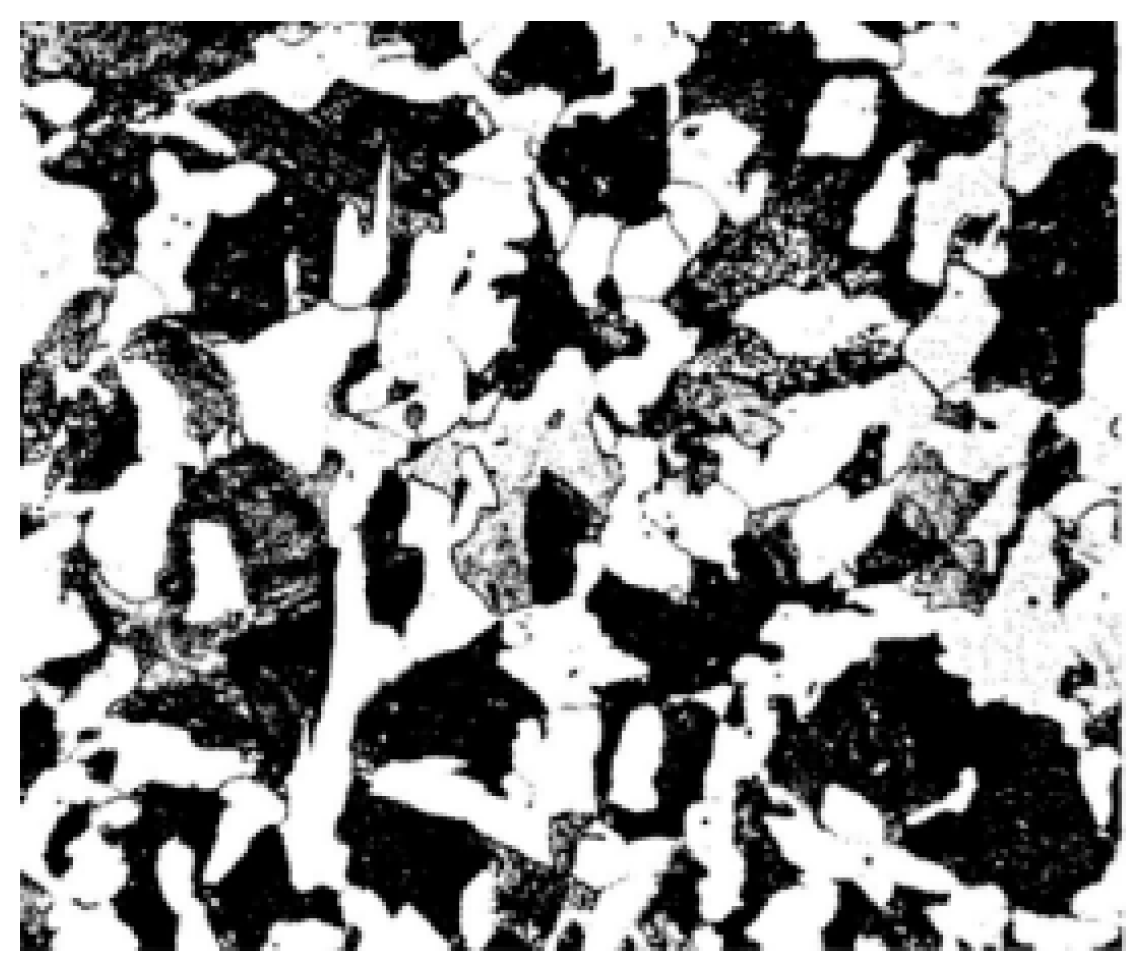
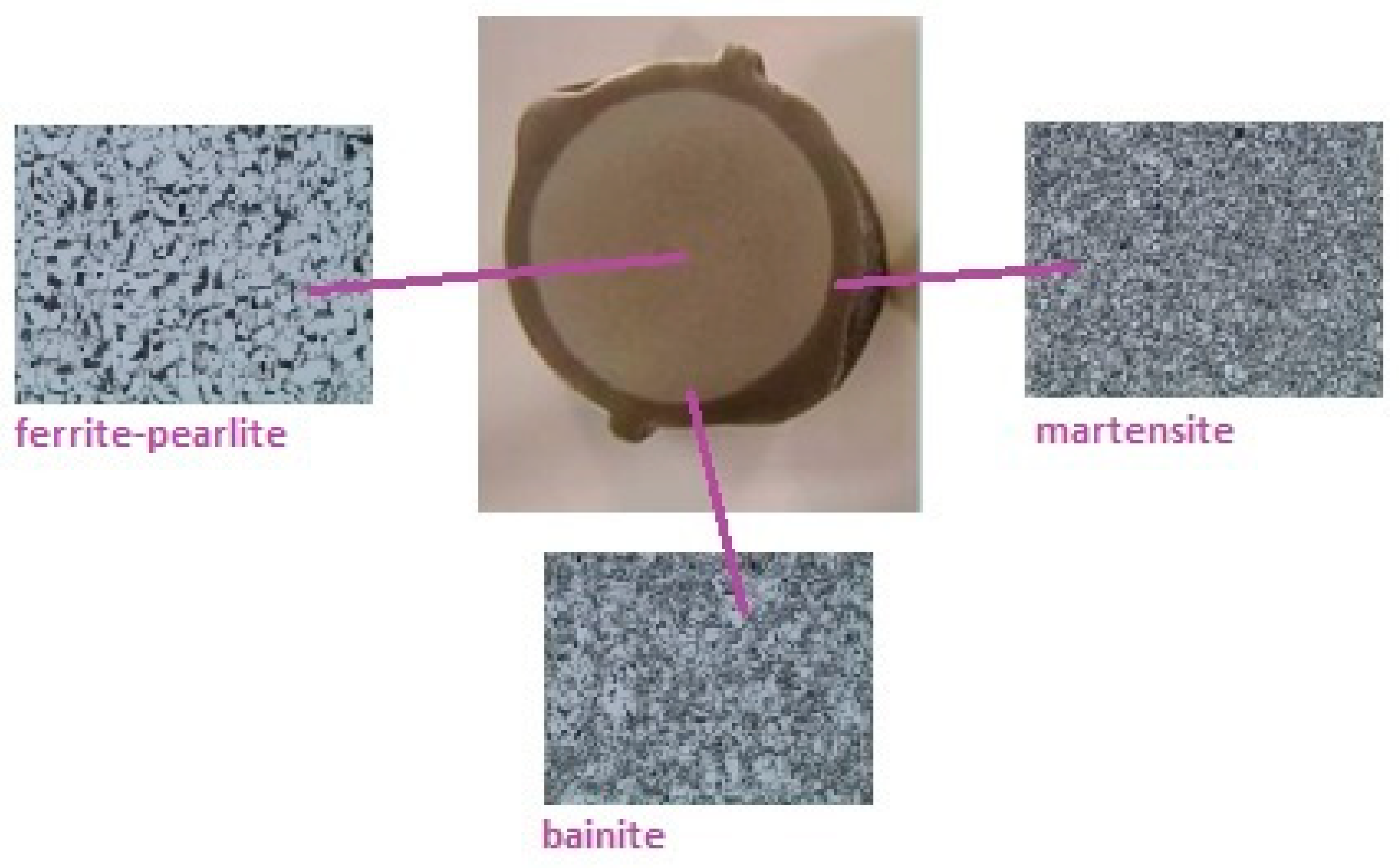

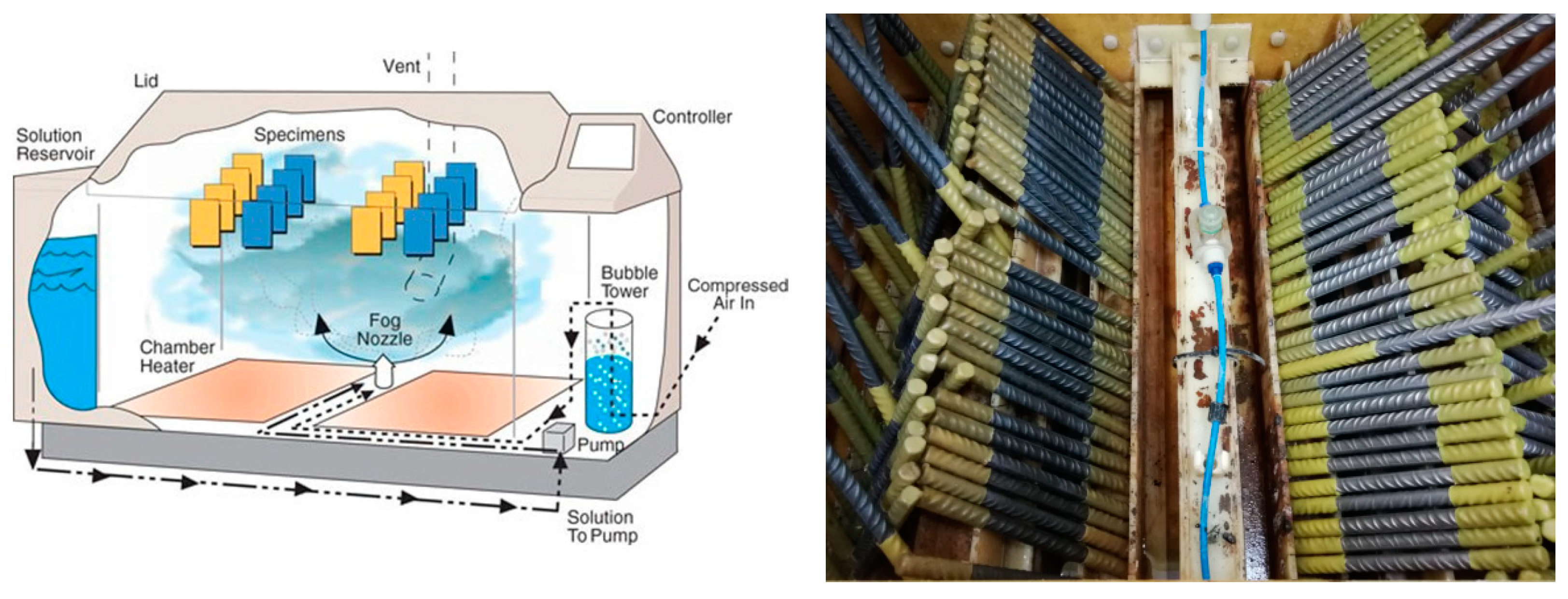
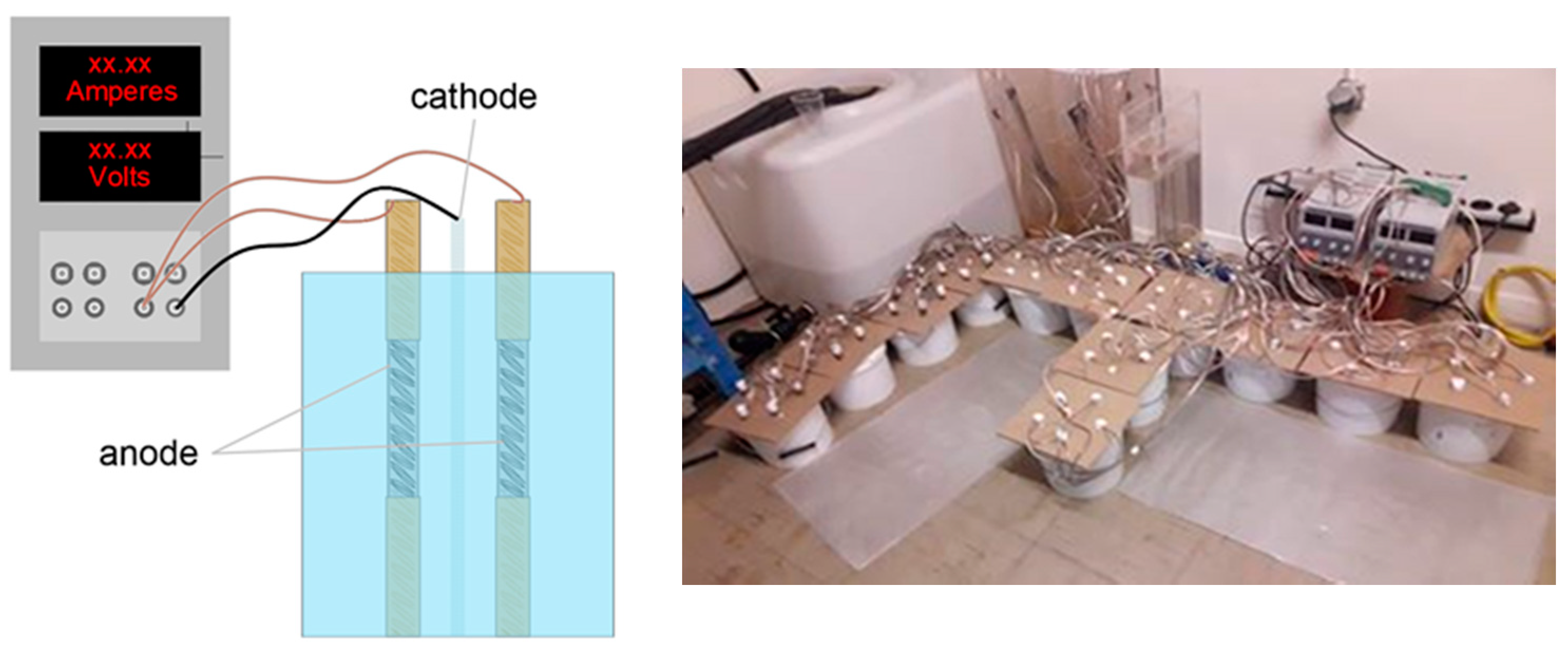


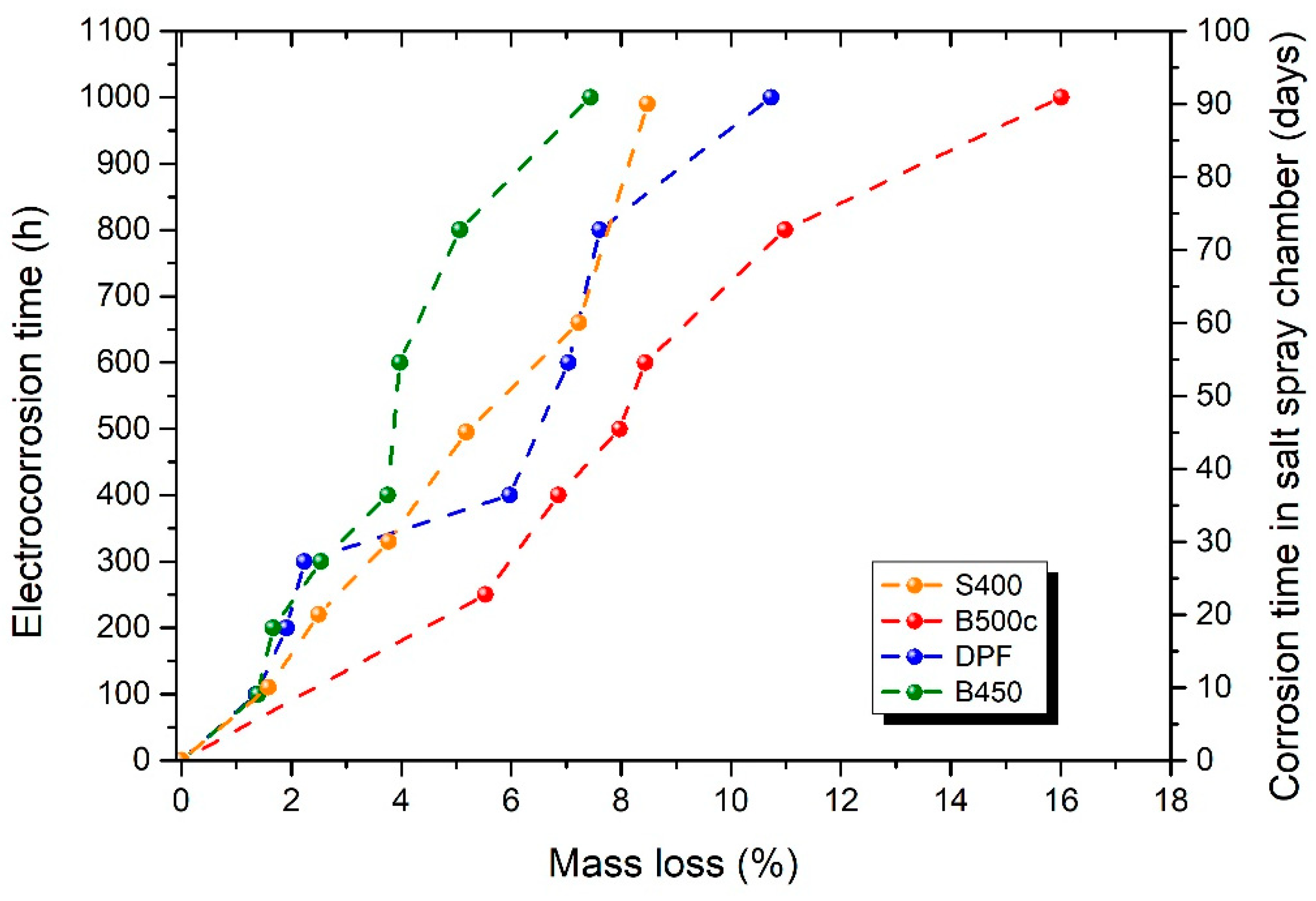
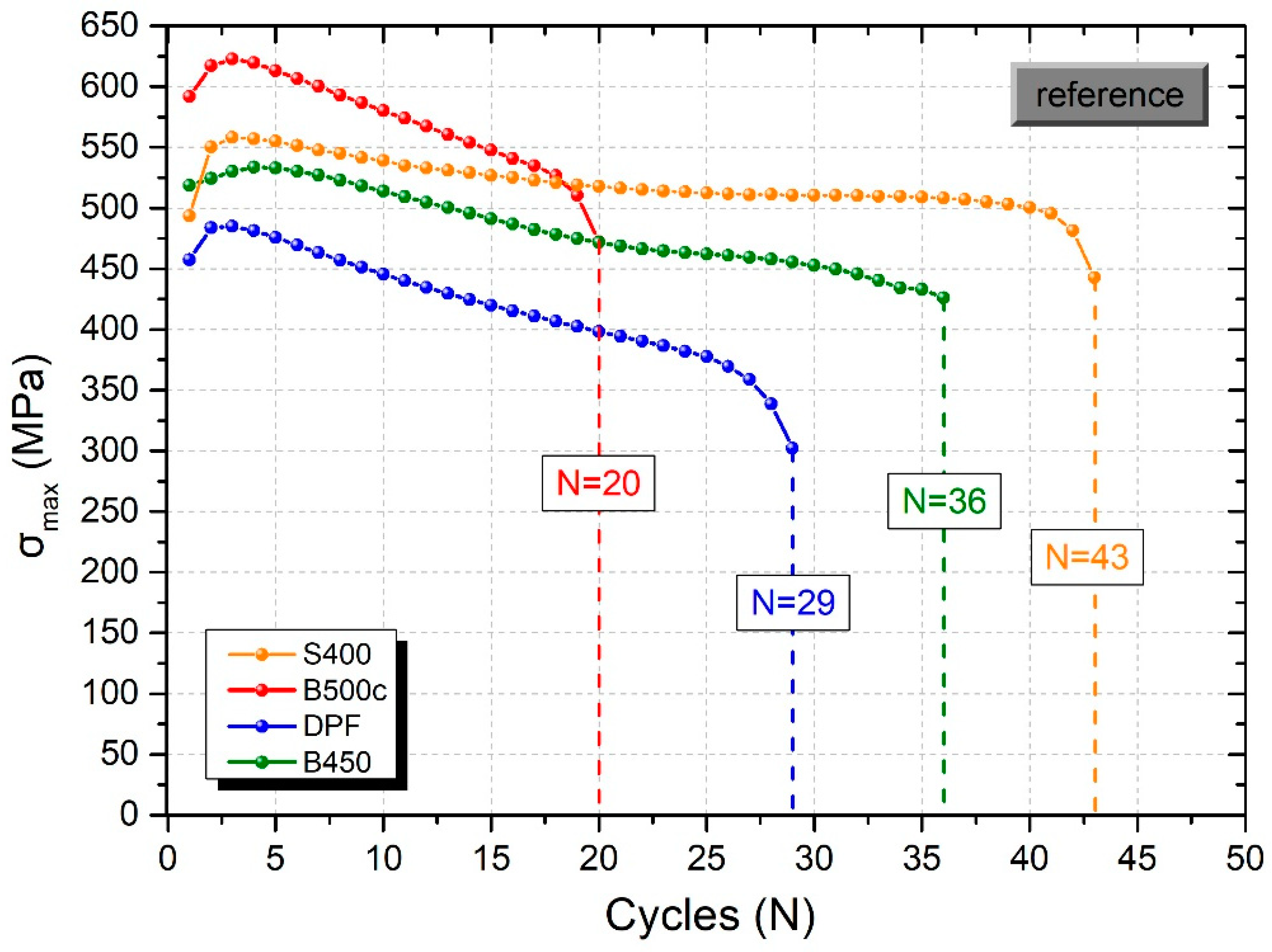
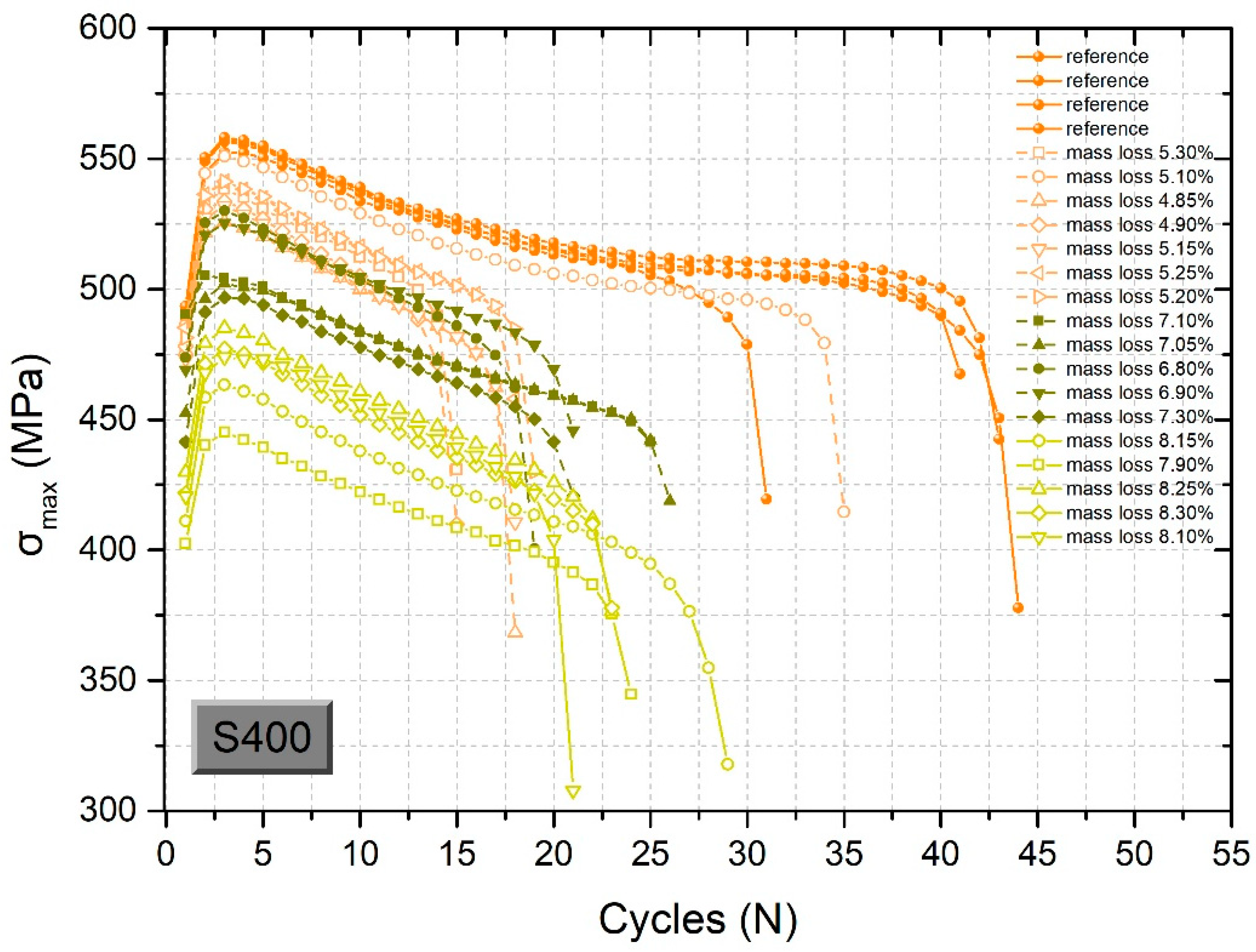
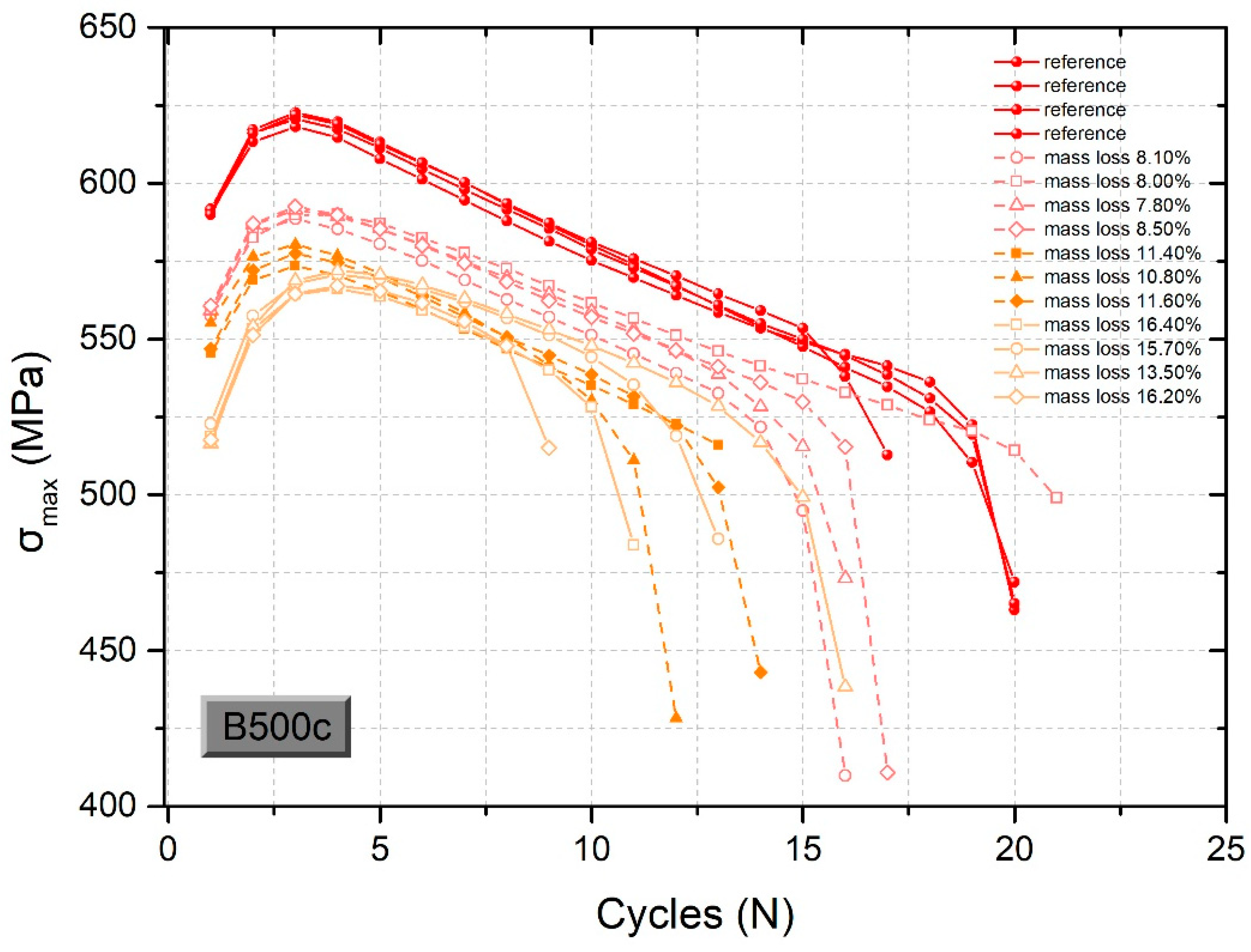
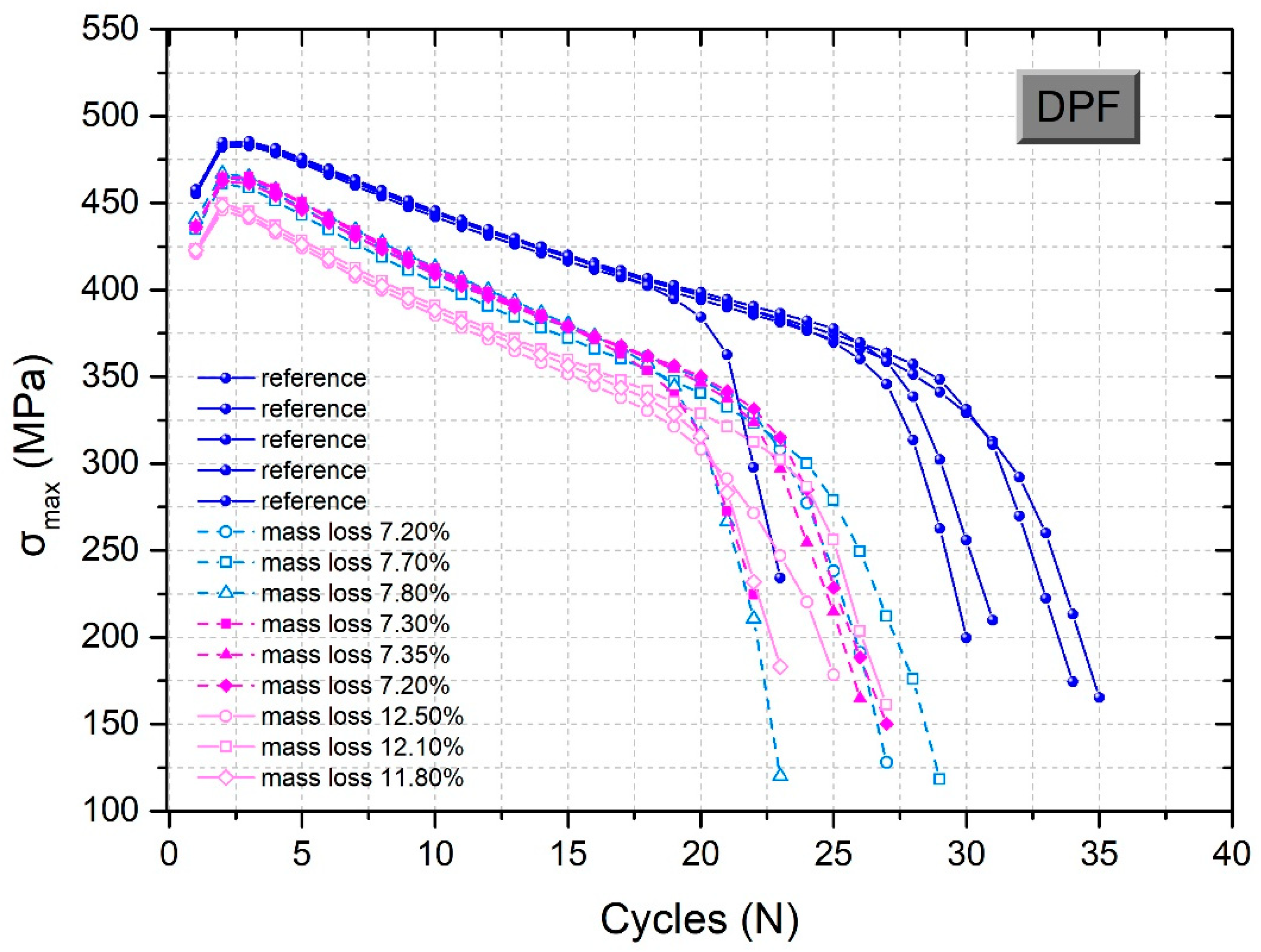
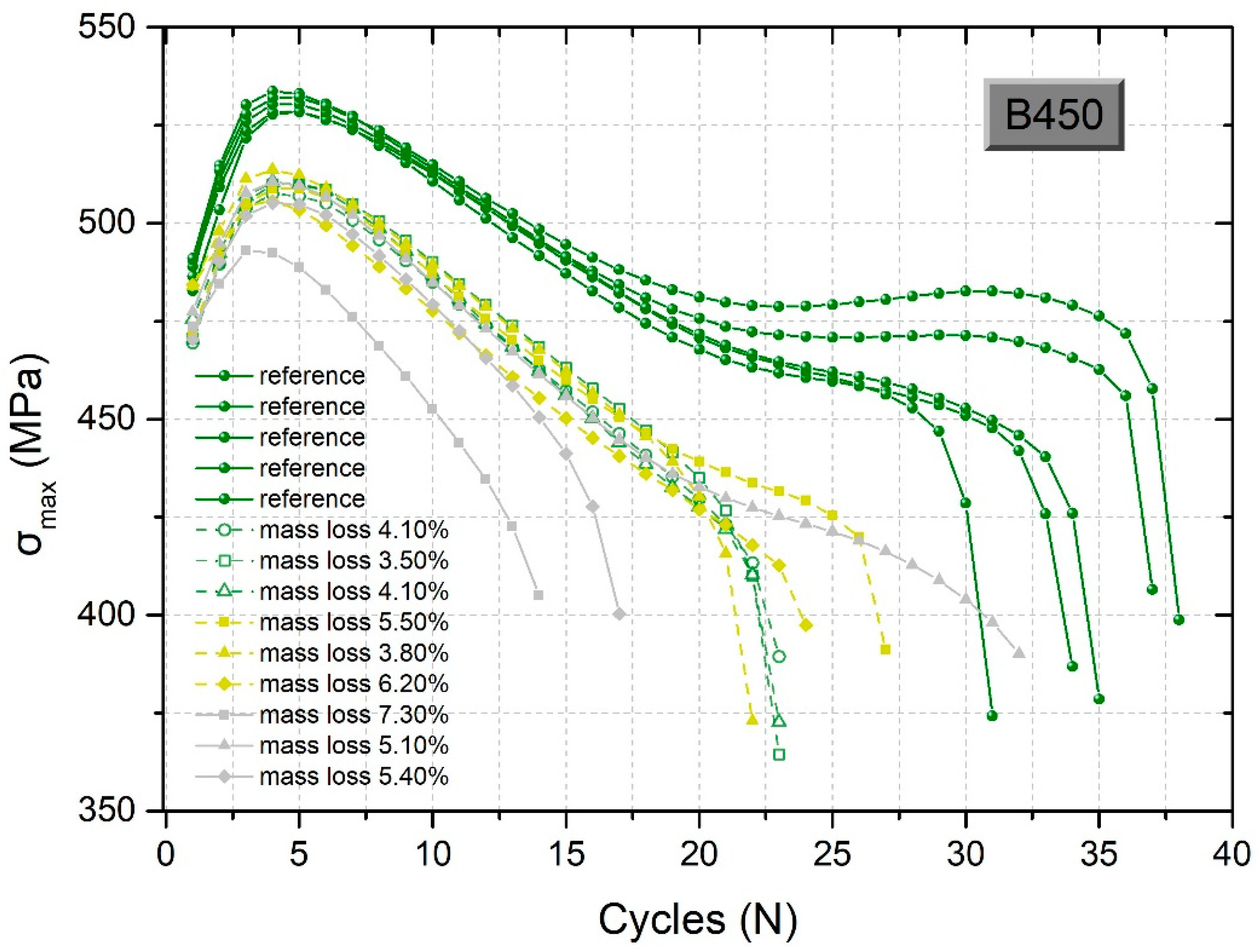


| Steel Type | C | Mn | Si | P | S | Cu | N | Cr | Ni | Mo | V | Ceq |
|---|---|---|---|---|---|---|---|---|---|---|---|---|
| (%) | (%) | (%) | (%) | (%) | (%) | (%) | (%) | (%) | (%) | (%) | (%) | |
| S400 | 0.35 | 0.94 | 0.26 | 0.013 | 0.026 | 0.42 | 0.010 | 0.16 | 0.10 | 0.023 | 0.002 | - |
| B500c | 0.22 | 0.87 | 0.193 | 0.015 | 0.047 | 0.261 | - | 0.082 | 0.106 | 0.014 | 0.001 | 0.409 |
| B450 | 0.233 | 0.646 | 0.138 | 0.0184 | 0.0422 | 0.371 | 0.0117 | 0.080 | 0.113 | 0.0187 | - | 0.393 |
| DPF | 0.160 | 0.999 | 0.166 | 0.0303 | 0.0099 | 0.372 | 0.0118 | 0.166 | 0.137 | 0.0303 | - | 0.400 |
| Corrosion Time (h) | Mass Loss (%) | ||
|---|---|---|---|
| B500c | B450 | DPF | |
| 0 | - | - | - |
| 100 | - | 1.39 | 1.36 |
| 200 | - | 1.67 | 1.91 |
| 250 | 5.53 | - | - |
| 300 | - | 2.54 | 2.24 |
| 400 | 6.86 | 3.75 | 5.97 |
| 500 | 7.97 | - | - |
| 600 | 8.44 | 3.97 | 7.04 |
| 800 | 10.98 | 5.06 | 7.61 |
| 1000 | 16.01 | 7.44 | 10.73 |
| Corrosion Time (Days) | Mass Loss (%) |
|---|---|
| S400 | |
| 0 | - |
| 10 | 1.58 |
| 20 | 2.50 |
| 30 | 3.77 |
| 45 | 5.18 |
| 60 | 7.23 |
| 90 | 8.48 |
| Corrosion Time (Days) | Mass Loss (%) | Cycles (N) | σmax (MPa) | Energy Density Wd (MPa) |
|---|---|---|---|---|
| 0 | - | 43 | 542.09 | 1059.00 |
| 10 | 1.58 | 27 | 540.97 | 723.00 |
| 20 | 2.50 | 21 | 535.32 | 725.00 |
| 30 | 3.77 | 26 | 544.55 | 693.50 |
| 45 | 5.18 | 24 | 556.17 | 628.75 |
| 60 | 7.23 | 24 | 543.25 | 627.40 |
| 90 | 8.48 | 24 | 512.92 | 587.00 |
| Corrosion Time (h) | Mass Loss (%) | Cycles (N) | σmax (MPa) | Energy Density Wd (MPa) |
|---|---|---|---|---|
| 0 | - | 20 | 620.87 | 571.85 |
| 250 | 5.53 | 22 | 598.91 | 623.80 |
| 400 | 6.86 | 21 | 593.46 | 579.03 |
| 500 | 7.97 | 18 | 588.11 | 495.35 |
| 600 | 8.44 | 18 | 590.65 | 497.84 |
| 800 | 10.98 | 14 | 577.12 | 388.11 |
| 1000 | 16.01 | 13 | 568.96 | 321.95 |
| Corrosion Time (h) | Mass Loss (%) | Cycles (N) | σmax (MPa) | Energy Density Wd (MPa) |
|---|---|---|---|---|
| 0 | - | 33 | 484.20 | 652.67 |
| 100 | 1.36 | 29 | 472.62 | 621.72 |
| 200 | 1.91 | 30 | 492.59 | 657.53 |
| 300 | 2.24 | 33 | 477.39 | 655.64 |
| 400 | 5.97 | 26 | 462.06 | 543.77 |
| 600 | 7.04 | 25 | 464.05 | 532.34 |
| 800 | 7.61 | 25 | 463.80 | 525.82 |
| 1000 | 10.73 | 25 | 448.08 | 510.33 |
| Corrosion Time (h) | Mass Loss (%) | Cycles (N) | σmax (MPa) | Dissipated Energy Wd (MPa) |
|---|---|---|---|---|
| 0 | - | 36 | 530.62 | 789.92 |
| 100 | 1.39 | 35 | 528.62 | 825.37 |
| 200 | 1.67 | 33 | 442.52 | 774.86 |
| 300 | 2.54 | 28 | 508.46 | 654.16 |
| 400 | 3.75 | 28 | 525.08 | 557.88 |
| 600 | 3.97 | 23 | 509.31 | 568.13 |
| 800 | 5.06 | 25 | 509.37 | 596.23 |
| 1000 | 7.44 | 22 | 502.88 | 529.19 |
| Corrosion Time (Days) | Mass Loss (%) | Factor KD | Factor Qo | Fatigue Index Qd |
|---|---|---|---|---|
| 0 | - | 1.0000 | 1059.00 | 1059.00 |
| 10 | 1.58 | 0.7969 | 338.07 | 272.21 |
| 20 | 2.50 | 0.7802 | 361.01 | 278.92 |
| 30 | 3.77 | 0.8074 | 283.08 | 228.86 |
| 45 | 5.18 | 0.8423 | 290.83 | 251.08 |
| 60 | 7.23 | 0.8038 | 171.31 | 136.98 |
| 90 | 8.48 | 0.7164 | 178.95 | 128.35 |
| Corrosion Time (h) | Mass Loss (%) | Factor KD | Factor Qo | Fatigue Index Qd |
|---|---|---|---|---|
| 0 | - | 1.0000 | 571.85 | 571.85 |
| 250 | 5.53 | 0.7756 | 783.42 | 606.33 |
| 400 | 6.86 | 0.7753 | 620.47 | 481.60 |
| 500 | 7.97 | 0.7663 | 385.57 | 295.08 |
| 600 | 8.44 | 0.7594 | 397.35 | 302.25 |
| 800 | 10.98 | 0.7511 | 182.67 | 136.30 |
| 1000 | 16.01 | 0.7321 | 123.51 | 90.33 |
| Corrosion Time (h) | Mass Loss (%) | Factor KD | Factor Qo | Fatigue Index Qd |
|---|---|---|---|---|
| 0 | - | 1.0000 | 718.46 | 718.46 |
| 100 | 1.36 | 0.7821 | 285.43 | 223.97 |
| 200 | 1.91 | 0.8147 | 392.37 | 266.62 |
| 300 | 2.24 | 0.7917 | 428.86 | 319.66 |
| 400 | 5.97 | 0.7308 | 200.53 | 146.72 |
| 600 | 7.04 | 0.7350 | 187.57 | 137.69 |
| 800 | 7.61 | 0.7340 | 187.18 | 137.35 |
| 1000 | 10.73 | 0.686 | 158.37 | 108.58 |
| Corrosion Time (h) | Mass Loss (%) | Factor KD | Factor Qo | Fatigue Index Qd |
|---|---|---|---|---|
| 0 | - | 1.0000 | 905.02 | 905.02 |
| 100 | 1.39 | 0.8079 | 713.97 | 579.18 |
| 200 | 1.67 | 0.6628 | 573.82 | 381.74 |
| 300 | 2.54 | 0.7619 | 329.37 | 251.79 |
| 400 | 3.75 | 0.7299 | 375.82 | 274.74 |
| 600 | 3.97 | 0.735 | 217.96 | 160.69 |
| 800 | 5.06 | 0.744 | 259.51 | 193.65 |
| 1000 | 7.44 | 0.731 | 233.93 | 172.07 |
Disclaimer/Publisher’s Note: The statements, opinions and data contained in all publications are solely those of the individual author(s) and contributor(s) and not of MDPI and/or the editor(s). MDPI and/or the editor(s) disclaim responsibility for any injury to people or property resulting from any ideas, methods, instructions or products referred to in the content. |
© 2024 by the authors. Licensee MDPI, Basel, Switzerland. This article is an open access article distributed under the terms and conditions of the Creative Commons Attribution (CC BY) license (https://creativecommons.org/licenses/by/4.0/).
Share and Cite
Basdeki, M.; Koulouris, K.; Apostolopoulos, C. Experimental Study on the Dynamic Response of Different Grades of Corroded Steel Reinforcement. Buildings 2024, 14, 2598. https://doi.org/10.3390/buildings14092598
Basdeki M, Koulouris K, Apostolopoulos C. Experimental Study on the Dynamic Response of Different Grades of Corroded Steel Reinforcement. Buildings. 2024; 14(9):2598. https://doi.org/10.3390/buildings14092598
Chicago/Turabian StyleBasdeki, Maria, Konstantinos Koulouris, and Charis Apostolopoulos. 2024. "Experimental Study on the Dynamic Response of Different Grades of Corroded Steel Reinforcement" Buildings 14, no. 9: 2598. https://doi.org/10.3390/buildings14092598






